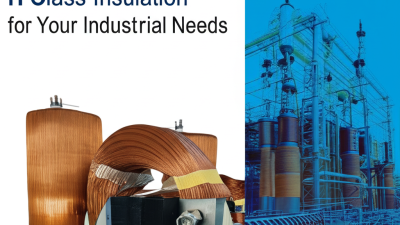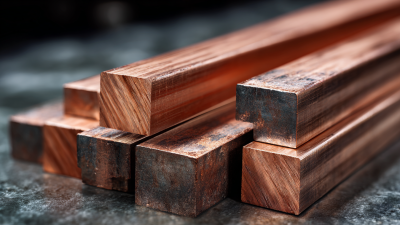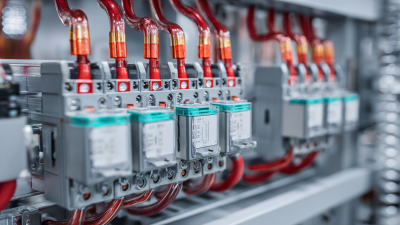Ultimate Guide to Choosing the Right Silver Plated Bus Bar for Your Applications
Table of Contents
- Factors to Consider When Selecting Silver Plated Bus Bars for Electrical Applications
- Understanding the Different Types of Silver Plated Bus Bars Available on the Market
- Key Performance Metrics to Evaluate in Silver Plated Bus Bars
- Installation Tips for Maximizing the Efficiency of Silver Plated Bus Bars
- Common Mistakes to Avoid When Choosing Silver Plated Bus Bars for Your Projects
- Maintenance Practices to Extend the Lifespan of Silver Plated Bus Bars
- Maximizing Efficiency: The Advantages of Using High-Quality Laminated Bus Bars in Electrical Systems
- FAQS
- Conclusion
- Related Posts
In today's constantly changing world of electrical connections, choosing the right materials is more important than ever if you want things to run smoothly and reliably. Lately, Silver Plated Bus Bars have been getting a lot of attention—and for good reason! They offer incredible conductivity and are pretty resistant to corrosion, which is a big plus. Industry reports predict that by 2025, the global bus bar market could hit around USD 21.8 billion, with more and more folks looking for high-performance electrical parts. Here at Sichuan D&F Electric Co., Ltd., we understand how crucial it is to pick the perfect Silver Plated Bus Bar for different applications—whether it's for industrial setups or renewable energy projects. We've been providing reliable electrical components and structural parts since 2005, aiming to help professionals make smarter choices that boost the lifespan and efficiency of their electrical systems.

Factors to Consider When Selecting Silver Plated Bus Bars for Electrical Applications
When you're choosing silver-plated bus bars for electrical work, there are a few things you really wanna think about to make sure they work well and last a while. One of the biggest factors is how thick the silver coating is. A thicker layer usually means better conductivity and more resistance to corrosion, but keep in mind, it could also bump up the price. So, it's all about finding that sweet spot between what you need and what you can afford.
Another thing to keep in mind is where you're gonna be using these bus bars. If they’re gonna face really high or low temperatures, or if they're exposed to stuff like corrosive chemicals, you’ll want to pick materials that can handle those conditions without giving you trouble. Also, don’t forget to check the size and connector type your system calls for—these little details can make a big difference in how smoothly everything connects.
Pro Tip: Always ask the manufacturers about proper care and maintenance for your silver-plated bus bars. Regular cleaning and inspections can seriously extend their life and keep everything running reliably.
Another tip: Take a second to review your whole system design. Make sure the bus bars you choose will fit well with the other components to avoid any headaches when you're installing them or down the line.
Understanding the Different Types of Silver Plated Bus Bars Available on the Market
When you're choosing silver-plated bus bars for your electrical projects, it’s pretty important to get a good handle on the different types out there. Basically, you’re looking at two main kinds: solid and laminated. Solid silver-plated bus bars are kinda the go-to for really high current stuff because they’ve got great conductivity and are super strong. I read somewhere—like in a recent report by the IEC—that these solid bars can actually conduct electricity up to about 106% of copper’s level. That’s pretty impressive, especially if you’re trying to cut down on energy loss.
Now, on the flip side, laminated silver-plated bus bars are more flexible and lighter, so they’re often the better pick when space is tight. The ANSI/IEEE standards point out that these laminated options do a pretty good job of dissipating heat, which is great for avoiding issues like thermal expansion and keeping things safe when you’re dealing with tight electrical setups.
In the end, choosing between solid and laminated really depends on what your specific needs are—things like how much current you need, environmental factors, and how you’re managing heat. It’s all about matching the right type to your application, really.

Key Performance Metrics to Evaluate in Silver Plated Bus Bars
When you're picking a silver-plated bus bar, it's really important to understand the key performance factors involved. First off, conductivity is a big deal. Since silver is one of the best conductors out there, it means less energy loss and better performance, especially in high-current setups. When you're checking out a bus bar, don't forget to look at how thick the silver plating is—thicker layers usually mean better conductivity and better resistance to corrosion, which helps it last longer and stay reliable in different kinds of environments.
Another thing to keep in mind is how well it handles heat. A good silver-plated bus bar should be able to get rid of heat efficiently during operation so it doesn’t overheat and keeps working smoothly. This isn’t just about having high thermal conductivity; the design also needs to help spread the heat out evenly. Oh, and don’t overlook the mechanical strength—you want a bus bar that's tough enough to handle the physical stresses during installation and everyday use without bending or breaking. Be sure to check the material specs to make sure it’s built to stand up to the demands of your application, no matter how tough they get.
Ultimate Guide to Choosing the Right Silver Plated Bus Bar for Your Applications - Key Performance Metrics to Evaluate in Silver Plated Bus Bars
| Metric | Description | Importance | Typical Value |
|---|---|---|---|
| Conductivity | Measures how easily electricity flows through the bus bar. | High conductivity is critical for efficient power distribution. | > 60% IACS |
| Thickness of Silver Plating | Defines the layer of silver coating on the bus bar. | Thicker plating leads to better performance and longevity. | 10-50 µm |
| Temperature Rise | Increase in temperature when carrying current. | Critical for assessing thermal management and safety. | |
| Mechanical Strength | Ability to withstand stress without deformation. | Essential for reliability in industrial applications. | > 200 MPa |
| Corrosion Resistance | Resistance to environmental damage. | Important for long-term durability in various conditions. | 5 years outdoors |
Installation Tips for Maximizing the Efficiency of Silver Plated Bus Bars
When you're installing silver-plated bus bars, paying close attention to detail really matters if you want them to work at their best. I’d suggest starting by making sure everything lines up properly and that the bus bars are snugly secured — loose connections can cause problems. It's also a good idea to clean the connection points well to get rid of any oxidation or dirt, because that stuff can mess with conductivity. When tightening the bolts or screws, using the right torque specs is key — it helps ensure you get a solid contact without over-tightening, which could lead to overheating or damage down the line.
Oh, and don’t forget about insulation and airflow around the bus bars. Keep the area dry and protected from moisture or corrosive stuff that might damage the metal over time. It’s smart to set up a regular check — just a quick inspection of those connections — so you catch any issues early before they become bigger problems. Also, think about how the materials expand and contract with heat; giving some room for movement can really help prevent stress and ensure everything stays reliable and runs smoothly for the long haul.
Ultimate Guide to Choosing the Right Silver Plated Bus Bar
This chart displays the efficiency ratings of different silver-plated bus bars based on their conductivity and thickness. Selecting the appropriate bus bar enhances electrical performance in various applications.
Common Mistakes to Avoid When Choosing Silver Plated Bus Bars for Your Projects
When you're choosing silver-plated bus bars for your project, it's really important to watch out for some common pitfalls that can mess with performance. A lot of folks underestimate how crucial it is to make sure the bus bars will work with their existing setup. Not all bus bars are created equal—some aren’t designed to handle every kind of electrical system out there. So, you’ve got to pay attention to the specific voltage and current your project needs. Skipping that step can lead to overheating or just not working as efficiently as you'd like.
And here’s another thing people often overlook—think about where and how the bus bars will be used. Things like temperature changes, humidity, or exposure to corrosive stuff can really impact how long these bars last and how well they perform. Picking a product that isn’t resistant enough to these conditions can cause things to break down sooner than you’d expect, which might force you to deal with expensive fixes later on. So, it’s a good idea to make sure the specifications match up with the environment you’re working in—trust me, it saves you headaches down the road.
Maintenance Practices to Extend the Lifespan of Silver Plated Bus Bars
 When it comes to keeping your silver-plated bus bars in good shape and lasting longer, having a solid maintenance routine is a total must. Honestly, doing regular visual checks really makes a difference—look out for tarnish or any signs of wear. I mean, if your bus bars get tarnished, their conductivity can drop, which probably messes with how well everything works. It’s a smart idea to schedule these inspections every now and then, so you catch any problems early on before they turn into big headaches.
When it comes to keeping your silver-plated bus bars in good shape and lasting longer, having a solid maintenance routine is a total must. Honestly, doing regular visual checks really makes a difference—look out for tarnish or any signs of wear. I mean, if your bus bars get tarnished, their conductivity can drop, which probably messes with how well everything works. It’s a smart idea to schedule these inspections every now and then, so you catch any problems early on before they turn into big headaches.
Cleaning is also super important. Grab a soft, non-abrasive cloth and a gentle cleaning solution—nothing too harsh—that’ll keep the surface looking good without risking damage. Be cautious with strong chemicals; they can cause corrosion or harm the finish. Plus, don’t forget to keep an eye on the environment around your bus bars. High humidity or heat can speed up oxidation, so if needed, consider adding moisture controls to keep things in check. By sticking to these simple maintenance tips, you’ll pretty much guarantee your silver-plated bus bars stay in great shape and perform at their best for a long time.
Maximizing Efficiency: The Advantages of Using High-Quality Laminated Bus Bars in Electrical Systems
In modern electrical systems, efficiency and reliability are paramount, and one of the key components contributing to these factors is the high-quality laminated bus bar. Also known as composite or low-inductance bus bars, these engineered components consist of carefully designed layers of conductive copper and thin dielectric materials. This construction not only enhances their mechanical strength but also reduces electromagnetic interference, making them ideal for a range of applications in industrial and commercial settings.
Laminated bus bars offer several advantages over traditional bus bar systems. Their unique design allows for a lower inductance, which plays a crucial role in minimizing power losses and thermal buildup. This is particularly important in high-frequency applications where efficiency is critical. Furthermore, the compact nature of laminated bus bars means they can fit into tighter spaces, streamlining electrical system layouts while ensuring optimal performance. By utilizing laminated bus bars, engineers can achieve greater energy efficiency, ultimately leading to cost savings and improved sustainability in electrical systems.
FAQS
: A thicker silver plating offers better conductivity and corrosion resistance, but it may also increase costs. It's important to evaluate the specific demands of your application to balance performance and budget.
The operating environment is crucial, as extreme temperatures or corrosive substances require materials that can withstand such conditions. Choose bus bars suited for your specific environmental factors.
There are primarily two types of silver plated bus bars: solid and laminated. Solid bus bars are best for high current applications due to their strength and conductivity, while laminated bus bars are lighter and more flexible, ideal for space-constrained applications.
Compatibility is essential because not all bus bars work with every electrical setup. Ensuring the voltage and current requirements match is vital to prevent overheating and maintain efficiency.
Environmental factors like temperature fluctuations, humidity, and exposure to corrosive elements can affect the durability of bus bars. Choosing materials resistant to these conditions is key to preventing premature failure.
Regular cleaning and inspection are important for maintaining silver plated bus bars. Consulting with manufacturers for proper maintenance practices can enhance their reliability and service life.
Common mistakes include underestimating compatibility with existing systems and neglecting the environmental conditions of operation. Both can lead to reduced efficiency and increased risk of failure.
Solid silver plated bus bars exhibit superior conductivity and strength, making them ideal for high current applications, while laminated bus bars are better for space-saving and effective heat dissipation in dense setups.
Conclusion
Hey there! So, in our 'Ultimate Guide to Picking the Right Silver Plated Bus Bar for Your Projects,' we break down everything you need to know to choose the perfect bus bars for different electrical tasks. We cover stuff like the different types out there, how to evaluate their performance, and even point out common mistakes folks often make when selecting them. Plus, we throw in some handy tips on installation to make sure everything runs smoothly and share maintenance advice to help these components last longer.
As a top manufacturer and supplier of electrical connection parts, Sichuan D&F Electric Co., Ltd. really understands how crucial these components are for keeping your electrical systems reliable. When you get a good handle on the ins and outs of silver plated bus bars, you’re in a much better spot to make smart choices that boost performance and give your projects a longer lifespan.
Related Posts
-

How to Choose the Best Tin Plated Copper Bus Bar for Your Electrical Needs
-

How to Achieve Maximum Energy Efficiency with H Class Insulation Solutions
-

Exploring the Unique Properties and Applications of Best Nomex T410 Film: A Comprehensive Guide for Buyers
-

7 Essential Tips for Choosing the Right H Class Insulation for Your Industrial Needs
-

The Future of Innovation in the Copper Aluminum Busbar Market
-

How to Choose the Right Flexible Busbar Solutions for Your Industrial Needs










